Did you know peace lilies have elegant green leaves and beautiful white flowers? They also clean the air. These plants are great for any room because they remove toxins.
In this guide, you’ll learn a lot about peace lilies. It doesn’t matter if you’re new to plants or not. You’ll learn how to take care of your peace lily and how to make more plants. Let’s learn about the amazing peace lilies!
Key Takeaways:
- Peace lilies are pretty and clean the air.
- This guide will help you learn to grow and take care of peace lilies.
- It’s for everyone, whether you’re experienced or new to growing plants.
- You’ll learn about picking pots, soil, light, and watering for your peace lily.
- Also, it covers how to make new plants, check for pests, and much more.
Why Do We Love the Peace Lily For Apartments?
Peace lilies are great for apartments. They make any space look better and clean the air. They’re also safe for pets. Plus, they fit well in small places. Let’s look at these reasons more closely.
Is the Peace Lily Air-Purifying?
Peace lilies clean the air well. They get rid of bad stuff like formaldehyde and benzene. They’re one of the top plants for clean air inside. Having a peace lily makes your home’s air healthier.
Is the Peace Lily Pet Friendly?
Pet owners, good news! Peace lilies are mostly safe for cats and dogs. But, if they eat the leaves, they might feel sick. Always check with a vet about your pets and plants.
How Big Does the Peace Lily Get?
Peace lilies are just right for small homes. They can grow from 1 to 4 feet tall. They don’t need much space and still look beautiful. You can easily fit them in your home.
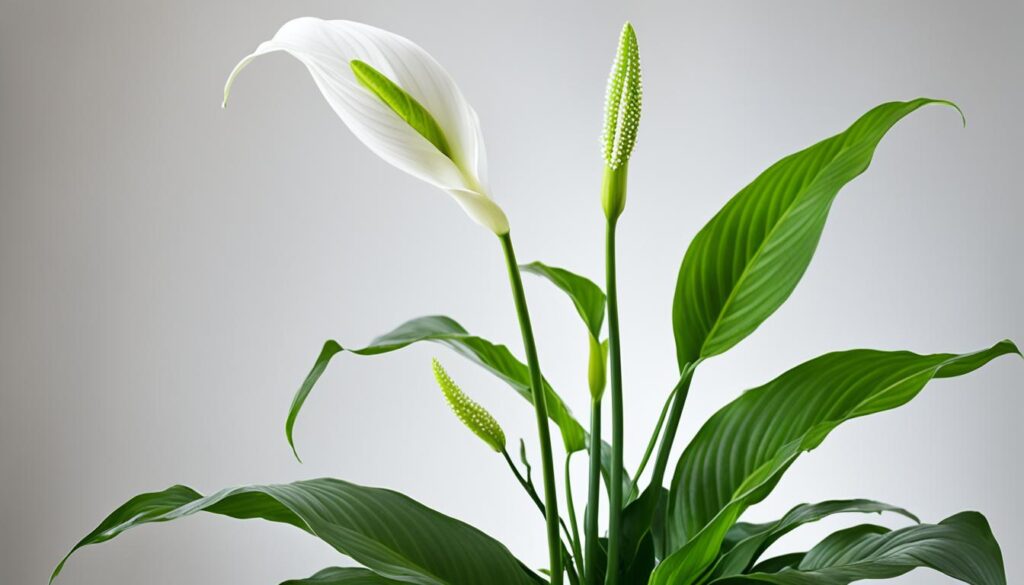
How to Grow a Peace Lily – Learn to Grow this Indoor Beauty
To grow a peace lily, you need to know what it likes. Things like the right pot, soil, light, water, and air moisture matter a lot. We’ll also talk about how to feed it, keep it trimmed, make more plants from it, and keep bugs away.
Choosing the Right Pot and Soil
Pick a pot with holes at the bottom for your peace lily. This stops the roots from getting too wet, which is bad. Use a pot that’s a bit bigger than your plant, so it has space to grow.
The soil should drain well but keep some moisture. Mix peat moss, perlite, and vermiculite, or use a special potting mix made for indoor plants.
Providing Adequate Light
Peace lilies like light, but not too much. Keep them near a window that doesn’t get too sunny. North or east-facing windows are perfect.
If there’s not enough natural light, use special plant lights. Keep these lights on for about 12-14 hours a day, not too close to the plant.
Watering and Humidity
Water your plant when the top inch of soil is dry. But don’t water too much. Give it enough water until it flows out the bottom of the pot.
Peace lilies like damp air. You can mist its leaves or put its pot on a wet pebble tray to make the air around it moist.
Nutrition and Fertilization
Use a good plant food diluted to half strength every couple of months in spring and summer. Don’t feed it in winter when it’s not growing much.
Pruning and Maintenance
Trimming your peace lily keeps it healthy and looking good. Cut off any yellow or old leaves and flowers with clean scissors. It helps the plant grow new parts.
Propagation
You can make new peace lilies by dividing them or using stem cuttings. For dividing, split the plant into pieces that each have roots. Plant them in new pots.
For stem cuttings, cut a healthy piece and put it in water or soil until it roots. Then plant it in a pot.
Monitoring for Pests and Diseases
Look closely at your plant for bugs like spider mites or diseases like root rot. If you find any, deal with them quickly. Use bug spray or natural ways to keep your plant healthy.
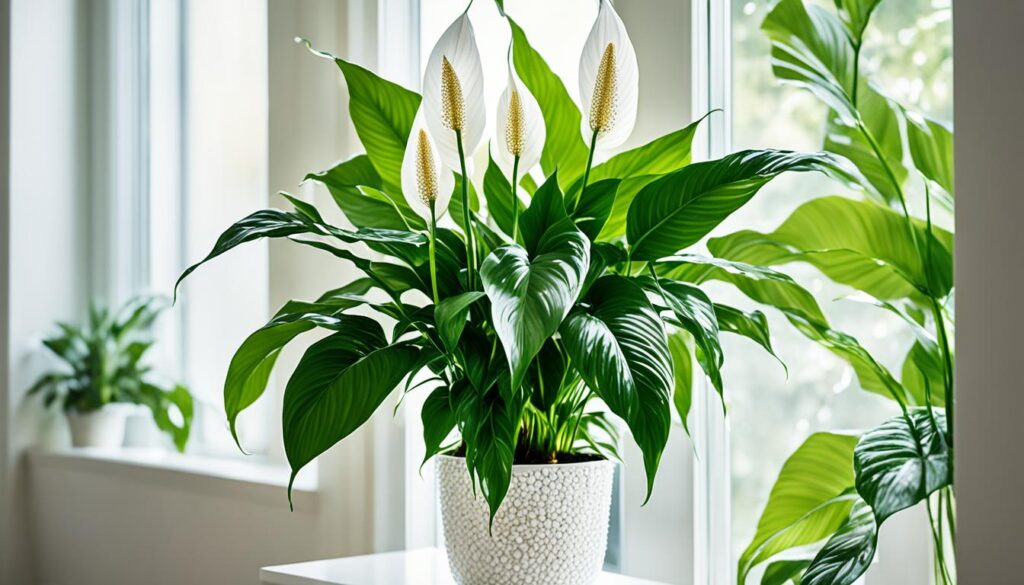
Appearance of Peace Lily
The peace lily is also called Spathiphyllum. It looks elegant and lush. Its leaves are green and shiny. They make a beautiful setting for its white flowers.
Peace lilies have big, dark green leaves. The leaves are shiny and feel like leather. They stand up and curve nicely. This makes the peace lily look special.
The peace lily has white flowers that stand out. They grow from the center and stand over the leaves. The flowers look like white sails. They add beauty and elegance everywhere.
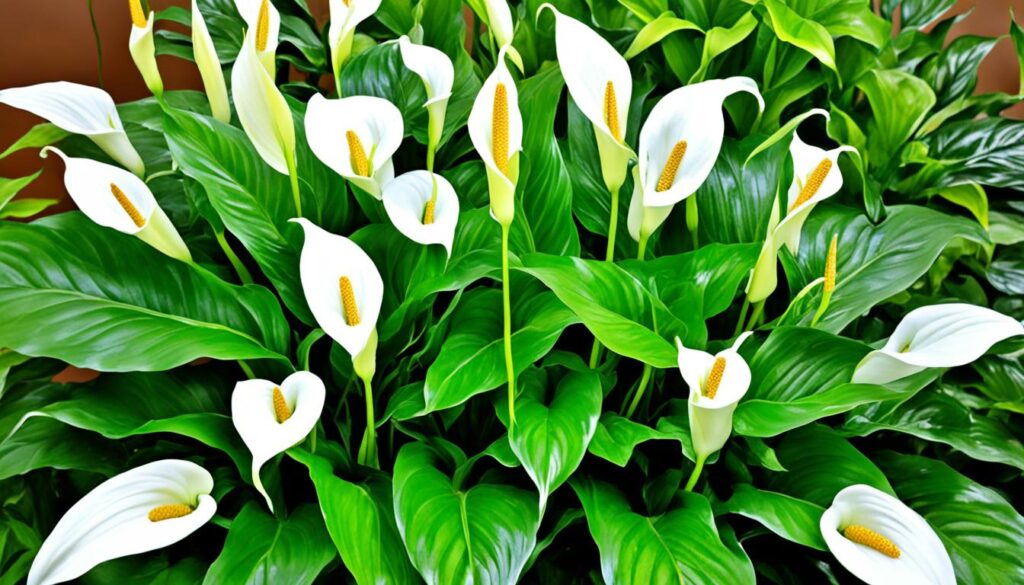
People who love indoor plants like the peace lily a lot. It makes any room feel calm and peaceful. You can put it on a table, shelf, or use it as a centerpiece. The peace lily brings the beauty of nature inside.
Light Requirements for Peace Lily
Light is key for peace lilies to grow well. It’s important to know how much light they need.
These plants do well in low to medium light. They like bright, but not direct, light like their home in the rainforests.
Put your peace lily by a window that faces north or east. This gives it the light it likes without harm.
If you don’t have a good window, use fluorescent lights for 12-16 hours a day. This is great for offices with little sunlight.
Peace lilies can grow in dim light, but not as fast or with many flowers. Yellow leaves mean it needs more light.
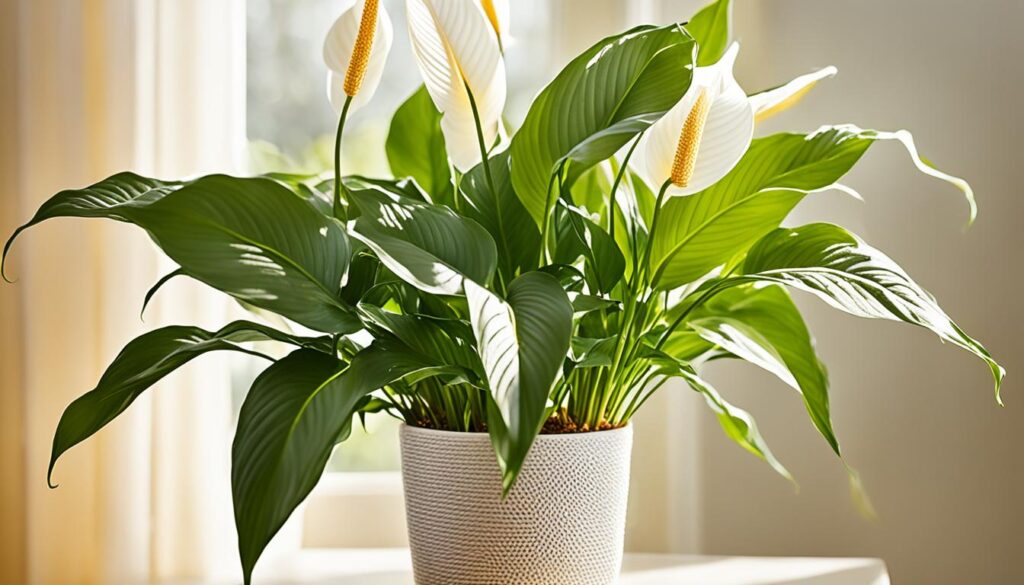
Turn your plant every few weeks. This makes sure all sides get light equally.
Right light makes peace lilies have green leaves and lovely flowers.
Watering Requirements of the Peace Lily
Watering your peace lily the right way is very important. These plants need just the right amount of water to grow well. If you give them too much or too little water, problems can happen. These include root rot and slow growth. Keeping the soil moist but not wet is the key to a happy peace lily.
Signs of Overwatering vs. Underwatering
It’s important to know if you’re giving your peace lily too much or too little water. Giving it too much water can hurt the roots. Signs that you’re watering too much include:
- Yellowing leaves
- Wilting or drooping foliage
- Fungus or mold growth in the soil
- A foul smell from the pot
Not giving enough water can also hurt your peace lily. It can get dry and unhappy. Signs of not enough water include:
- Wilting leaves that stay wilted after you water
- Dry and brittle leaves
- Brown or crispy leaf edges
- Yellow or brown lower leaves
Watch your peace lily closely to know how to water it just right.
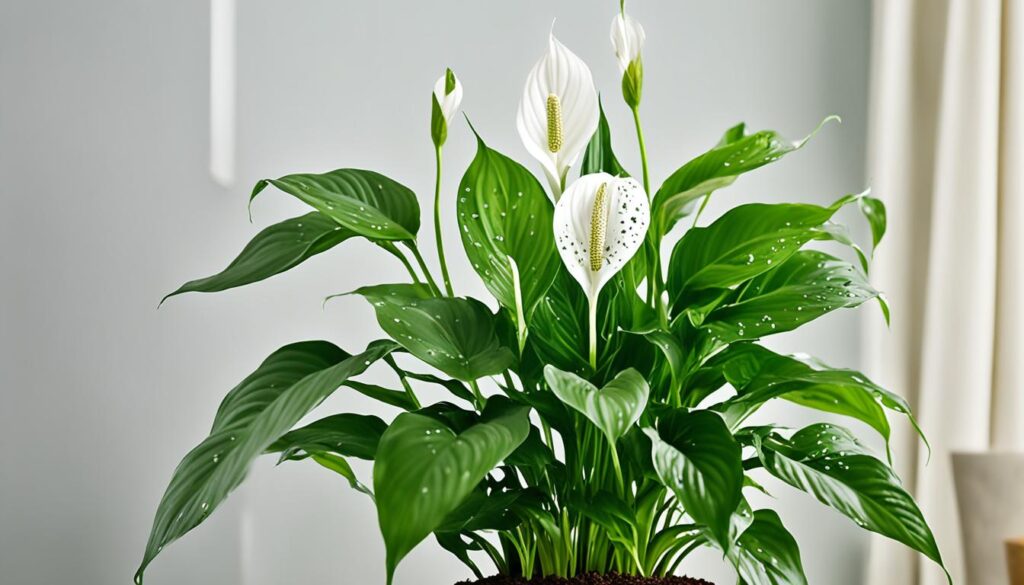
Fertilizing a Peace Lily
Peace lilies need little care but fertilizing helps them grow well. Fertilizers give them needed nutrients not found in soil. I’ll talk about why and how to fertilize peace lilies for the best growth.
Recommended Fertilizer for a Peace Lily
It’s important to pick a fertilizer that is balanced. Use a water-soluble, all-purpose one. Look for ratios like 20-20-20 or 10-10-10. These numbers show the percentage of nitrogen, phosphorus, and potassium.
The needs for fertilizer change depending on the plant size and soil. It’s a good idea to fertilize your peace lily every two to four weeks in spring to early fall.
When you fertilize, follow the package instructions and water your plant well. Avoid giving it too much to prevent harm. If the leaves turn brown or the plant looks sick, use less fertilizer.
Plants are all different, so watch how your peace lily reacts. Change how often or much you fertilize based on what your plant needs.
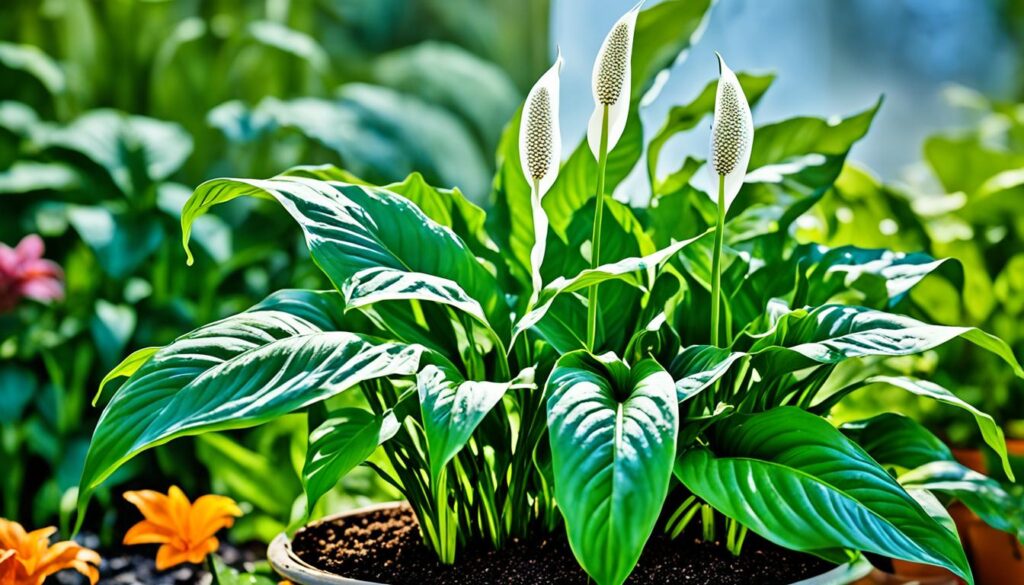
Potting a Peace Lily
Proper potting helps your peace lily stay healthy. It’s important to choose the right pot size and mix. You also need to know when to repot. This guide will help you care for your peace lily well.
Choosing the Right Pot Size
Choosing the right pot size is very important. A small pot can stop roots from growing. A big pot can hold too much water. Look at your peace lily’s roots to pick a good pot. It should be a bit bigger than the current one.
Using the Right Potting Mix for a Peace Lily
The potting mix is key for a healthy peace lily. Use a mix that drains well but stays a bit wet. Mix potting soil, peat moss, and perlite or vermiculite equally. This combo helps roots grow strong and healthy.
Repotting When Necessary
You need to know when to repot your peace lily. If it grows too much, it might need a new pot. Look for roots coming out of the holes, too crowded roots, or if the plant stops growing. Repot every 1-2 years, in spring.
Remove the peace lily carefully, loosen the roots, and put it in a new pot. Use new potting mix. Be gentle with the roots. Water it well after repotting.
These tips will help your peace lily thrive. It’ll be happy with the right care.
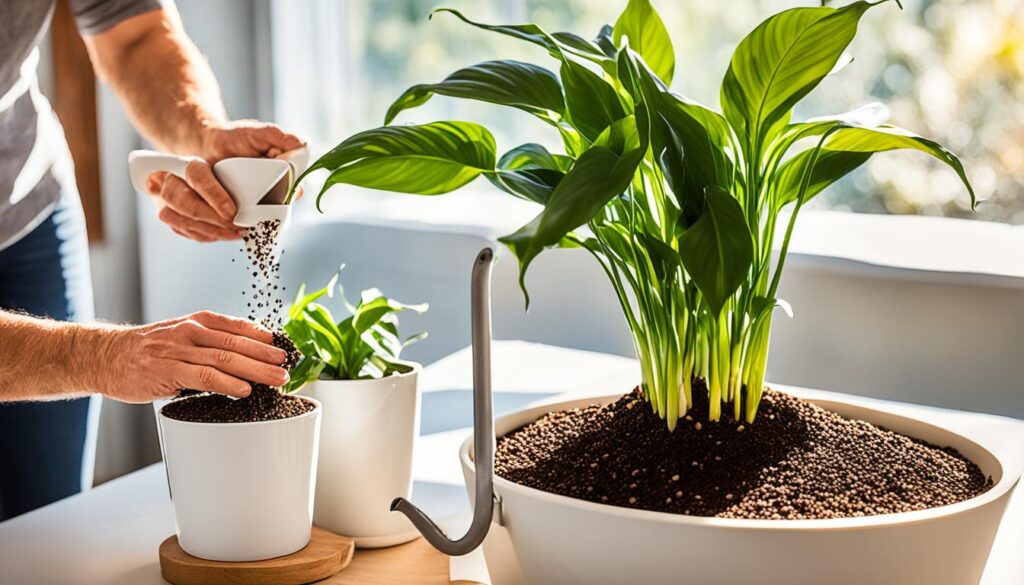
Propagating a Peace Lily
Want to grow your peace lily collection or share with friends? Propagating is a great way to do it. It’s done mainly through stem cuttings and division. These methods help your peace lily turn into a new plant.
Stem Cuttings Or Seeds?
Stem cuttings are the most used way to propagate peace lilies. You take a healthy piece of stem and let it grow roots. This method is good because the new plant will be just like the parent.
Here’s how to propagate with stem cuttings:
- Pick a healthy stem with 2 or 3 leaves.
- Cut the stem below a leaf node with a clean knife or scissors.
- Take off lower leaves, leaving only a couple at the top.
- Put the cutting in water, making sure the nodes are under water.
- Place it somewhere warm and bright, but not in direct sunlight.
- Change the water every few days to keep it clean.
- Soon, roots will grow from the nodes.
- When the roots are about an inch long, plant it in a pot with soil.
- Keep the soil moist and the area humid for growth.
- In a month, your new peace lily should be well on its way.
Division Of A Peace Lily
Division is another way to create new peace lilies. It’s used when a plant gets too big or you want to share. You separate the plant’s root clumps to make new ones.
Here are the steps for division:
- Take the plant out of its pot or the ground.
- Break the root clumps into smaller pieces. Each should have roots and leaves.
- Use your hands or a tool to split them.
- Washing off the soil might make dividing easier.
- Plant each piece separately in new pots with good soil.
- Water them well and keep the soil moist.
- They should be in a warm, bright place but out of direct sunlight.
- With care, these will grow into new peace lily plants.
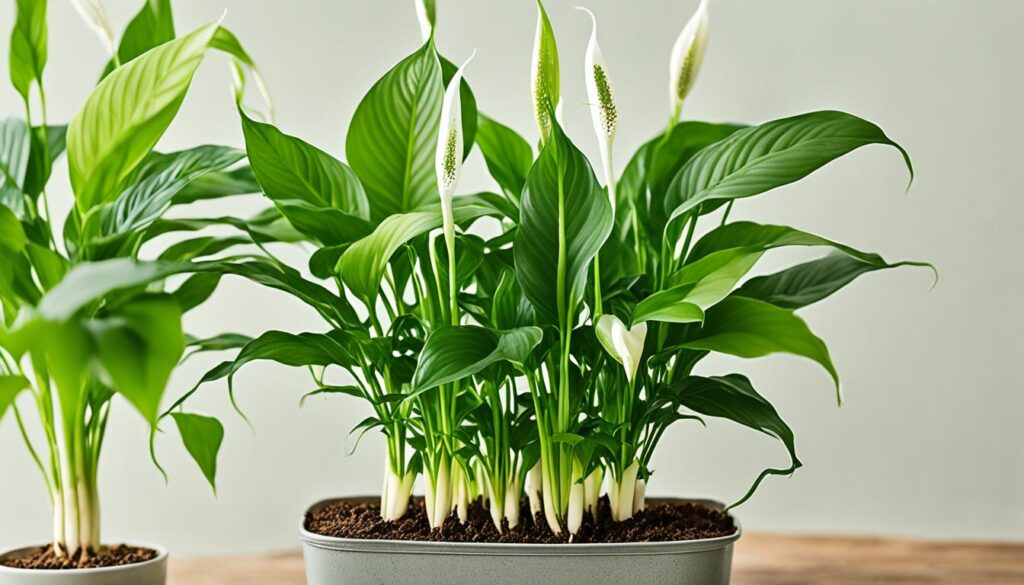
Growth and Development of the Peace Lily
It’s key to know how your peace lily grows. This helps keep it healthy. Every step of its life has special care needs.
Peace lilies grow in two main stages. First is the vegetative stage. Here, the plant makes its leaves and roots strong.
Next, it moves to the reproductive stage. This is when it flowers and makes seeds. When flowers show up, they bring beauty to any room.
After blooming, the flowers slowly go away. Peace lilies need help from bugs to make seeds. If they get it, they produce fruits with seeds inside.
Peace lilies make babies, called offsets, too. These little plants grow beside the big one. With care, they can grow into new plants.
Dealing with Pests and Diseases in the Peace Lily
Peace lilies can get sick from pests and diseases. I’ll tell you about common problems and how to fix them. This will help your plants stay healthy.
Pests like aphids and spider mites can harm peace lilies. They eat the plant and make it weak. Look for bugs, webs, sticky stuff, or odd leaves to spot them.
Keeping your lilies healthy helps avoid pests. Here are ways to do it:
- Regularly inspect your peace lilies: Check the leaves, stems, and undersides of the foliage for any signs of pests.
- Improve air circulation: Provide good airflow around your plants by spacing them appropriately and avoiding overcrowding.
- Isolate infected plants: If you notice a pest infestation, isolate the affected plant to prevent the pests from spreading to other healthy plants.
- Use natural predators: Introduce beneficial insects like ladybugs or predatory mites that feed on pests and help reduce their population.
- Try homemade remedies: Some homemade solutions like neem oil or insecticidal soap can be used to control certain pests. However, always follow the instructions and test on a small area of the plant before widespread use.
Diseases can also hurt peace lilies. Root rot and leaf spot are common. They come from too much water or not enough air. To keep your plants safe, try these tips:
- Proper watering: Avoid overwatering your peace lilies, as excessive moisture can lead to root rot. Allow the top inch of the soil to dry out before watering again.
- Improve drainage: Ensure that the pots have proper drainage holes to prevent water from accumulating at the bottom.
- Avoid overhead watering: Water the soil directly to avoid wetting the foliage, which can promote disease development.
- Remove affected leaves: If you notice any signs of disease, promptly remove the affected leaves to prevent further spread.
- Fungicidal treatments: In severe cases, you may need to use a fungicide specifically formulated for the identified disease. Follow the instructions carefully.
Stay alert and take care of your peace lilies. Watch them closely, give them what they need, and act fast if there’s a problem. This way, they’ll stay healthy and beautiful.
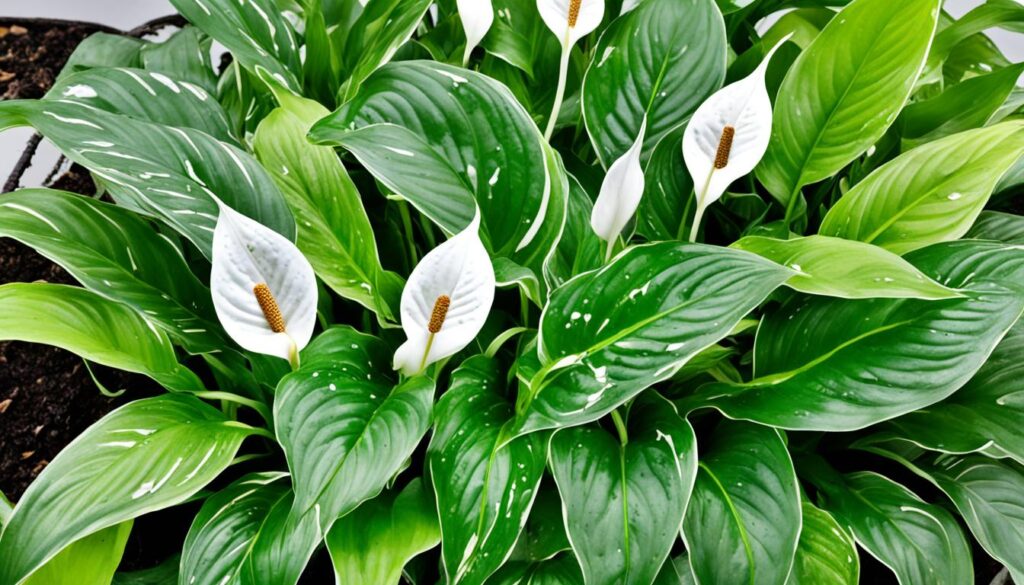
Common Peace Lily Pests
Peace lilies are beautiful houseplants. They can attract different common pests.
It’s important to identify and deal with these pests. This protects your peace lily’s health.
Here are some common pests that can infest peace lilies:
- Spider Mites: These tiny insects can be found on leaf undersides, causing yellowing and webs.
- Mealybugs: They are small, white insects that often gather on leaves, stems, and flowers. They can cause yellowing, stunted growth, and honeydew residue.
- Scale Insects: They appear as small, brown or tan bumps on leaves and stems. They can cause yellowing, wilting, and a sticky residue.
- Aphids: These are small, soft-bodied insects that eat plant sap. They can cause curling leaves, yellowing, and distorted growth.
To effectively deal with these pests, you can try these methods:
- For spider mites, use a strong water spray to wash them off. In severe cases, use insecticidal soap or neem oil.
- Mealybugs can be wiped off with a cotton swab dipped in alcohol. Use insecticidal soap or neem oil for control.
- To remove scale insects, scrape them off with a cotton swab soaked in alcohol. Insecticidal soap or neem oil also works.
- Control aphids by spraying them off with water. Use insecticidal soap. Ladybugs and lacewings can also help control them.
Regularly check your peace lily for pests. Act fast to keep it healthy and free from pests.
Natural Predators
There are also natural predators that help with pest control in peace lilies. These are good insects that eat the bad pests. By adding these friendly bugs to your garden, you can stop pests without using chemicals.
Isolate Infected Plants
If you see pests or sick spots on your peace lilies, keep them away from the others. This stops the pests from spreading. Move sick plants away and watch them to see if they get better or worse.
Chemical Treatment
Sometimes, you might need to use chemicals to fight pests. Chemicals are a last choice if everything else does not work or if there are a lot of pests. Make sure the chemicals are safe for peace lilies. Always follow the instructions to keep your plant and its surroundings safe.
Disease Prevention For Peace Lilys
Keeping peace lilies healthy is important. Use some simple tips to help them thrive.
Maintain Proper Hygiene: Clean plants are happy plants. Wipe their leaves with a damp cloth or a safe cleaner. This removes dirt and lets them breathe well.
Avoid Overwatering: Too much water can make peace lilies sick. These plants like their soil a bit moist, not wet. Make sure pots drain well. Don’t let water sit in saucers. Touch the soil. If it’s dry up to your first knuckle, water your plant.
Monitor Overall Health: Check your peace lilies often. Look out for yellow or wilting leaves and bugs. Catching problems early helps keep them healthy.
Tips for Maintaining Peace Lilys
Peace lilies need care to stay healthy. Follow simple tips to make your lilies look great.
Wiping Leaves
Wiping peace lily leaves keeps them clean. It helps them get light for food making. Use a soft, damp cloth for wiping. Be gentle to avoid leaf damage.
Outdoor Exposure
Peace lilies like being indoors but enjoy outside air too. Avoid too much sun. Place them in shade outside sometimes. Watch the weather to keep them safe.
Adjusting Watering Schedule
Watering depends on pot size, humidity, and air. Check soil moisture often. If dry, water your lilies. Don’t overwater to avoid root problems. Keep soil moist, not soggy.
Tips for Successful Overwintering of Peace Lily
If you live where it gets cold in winter, you’ll want to keep your peace lily happy. Overwintering means making sure your indoor plant does well when it’s cold. Here are key tips for keeping your peace lily thriving in winter:
1. Temperature: Peace lilies like it warm, between 60-75°F. Keep them from cold spots and windows. Try to keep the warmth steady.
2. Light: Winter means less sun. Put your peace lily near a window that faces south. If there’s not enough sunlight, use a grow light.
3. Humidity: Heating dries out the air indoors. Use a humidifier or a tray of water and stones to add moisture. Spraying the leaves helps too.
4. Watering: Water less in winter. Let the soil’s top inch get dry first. Too much water is bad. Make sure extra water can drain off.
5. Fertilization: Peace lilies grow slower in cold months. They don’t need much food. You might skip fertilizing or use less fertilizer.
6. Pest Prevention: Bugs can still bother indoor plants in winter. Look for troublemakers like spider mites. Use natural ways to keep pests away if you find any.
7. Pruning: Cut off any leaves that look bad. This helps the plant stay healthy. It also makes it look nice and ready for new growth in spring. Additionally, removing dead or damaged leaves allows the plant to redirect its energy toward producing new foliage, which can enhance its overall vitality. For those interested in enhancing their indoor or outdoor space, incorporating these ivy growing tips and techniques can lead to more robust and thriving plants. Regular pruning not only contributes to a more aesthetically pleasing plant but also encourages better air circulation and light penetration, promoting healthy growth throughout the seasons.
8. Monitoring: Watch how your peace lily is doing. Keep tabs on warmth, light, moisture, and water. This helps your plant stay happy all winter.
Use these tips and your peace lily will do great even when it’s cold. Change how you care for it based on what it needs and where you live.
Growing Peace Lily from Seed
Growing peace lilies from seeds can be fun and rewarding. I’ll show you how to do it, step by step.
To start, collect mature seeds from a peace lily. Look for brown, dry seed pods on the plant. When the pods open and turn brown, get the seeds out. Put them in a small container.
Next, you need good soil for the seeds. Use potting mix that drains well and has organic stuff in it. Put the mix in a tray or pots but leave a little space at the top.
Now, place the seeds on the soil. Make sure they’re spread out so they have room to grow. Push them gently into the soil. Then, cover them with a bit more mix or with vermiculite.
After planting, water the soil lightly so it’s moist all over. Don’t water too much or the seeds might rot. Put the tray or pots in a warm spot but not in direct sunlight.
Keep the soil moist by watering when the top feels dry. Spray the seedlings to keep them humid. Soon, you will see little plants coming up.
When the seedlings are big enough, move them to their own pots. Be gentle so you don’t hurt them. Use the same soil as before.
Keep looking after your baby peace lilies. Give them the right light, water, and moisture. They will grow up to have pretty leaves and white flowers.
Varieties of Peace Lily
Peace lilies come in many types. Each one has its own special look and perks. Some are small and fit on shelves. Others have big, bold flowers. There’s a perfect peace lily for everyone.
The Spathiphyllum wallisii is also called the Mauna Loa peace lily. It has dark leaves and pretty white flowers. Many people choose it for its classic beauty.
The Spathiphyllum sensation is a bigger peace lily. It has wide leaves and large white flowers. It makes any room look more interesting.
If you like smaller plants, the Spathiphyllum petite is great. It’s small but has lovely white flowers. It’s perfect for tight spaces or as a table plant.
FAQ
Q: Why are peace lilies popular for apartments?
A: Peace lilies are liked for small homes because they are beautiful and clean the air. They are also safe for pets and fit well in small places.
Q: What are the specific requirements for growing a peace lily?
A: Growing a peace lily needs the right pot and soil. You must give it enough light, water, and humidity.
Fertilize it right, prune it, and watch for pests. You can also make more plants from it.
Q: What do peace lilies look like?
A: Peace lilies have shiny green leaves. Their white flowers are very pretty.
Q: What are the light requirements for peace lilies?
A: Peace lilies need the right amount of light to grow well and be healthy.
Q: How should I water my peace lily?
A: It’s important to water your peace lily correctly. Knowing when it has too much or not enough water is key.
Q: Do peace lilies need to be fertilized?
A: Peace lilies don’t need a lot of food. But the right fertilizer makes them grow better and healthier.
Q: How do I pot a peace lily?
A: Potting a peace lily right is important for its health. Use the correct pot and soil. Know when to put it in a new pot.
Q: How can I propagate a peace lily?
A: You can make new peace lilies by cutting stems or dividing them. Each way has steps to follow for success.
Q: How does a peace lily grow and develop?
A: Knowing how a peace lily grows helps you care for it right. This ensures it stays healthy.
Q: What pests and diseases affect peace lilies?
A: Pests and diseases can harm peace lilies. It’s important to keep them healthy and deal with any problems.
Q: What are some common pests that infest peace lilies?
A: Peace lilies can get bugs like spider mites and mealybugs. Knowing how to stop these bugs is important.
Q: Are there natural predators and control methods for peace lily pests?
A: Yes, there are natural ways to deal with peace lily pests. You can isolate sick plants or use treatments if needed.
Q: How can I prevent diseases in my peace lilies?
A: Stopping diseases before they start is key. Keep your plants clean, don’t overwater, and check their health.
Q: What maintenance tips should I follow for peace lilies?
A: Take good care of your peace lilies to keep them happy. Look after their leaves, water them right, and protect them outside.
Q: How do I care for peace lilies during the winter months?
A: Caring for peace lilies in cold winter is important. It helps them continue to grow and bloom.
Q: Can I grow peace lilies from seeds?
A: Growing peace lilies from seeds is a fun project. Even though it’s not common, it can be rewarding.
Q: What are the different varieties of peace lilies?
A: There are many types of peace lilies. Each one is special in its own way. Exploring these can help you choose your favorite.

